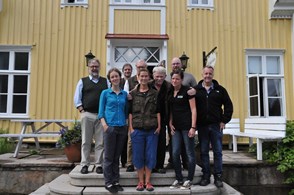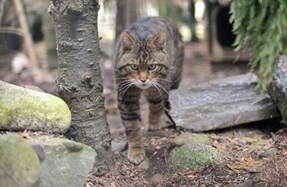Breeding for release – a lifeline for wildcats
08/01/2016 in Conservation
By David Barclay, RZSS Cat Conservation Project Officer
As 2016 begins it gives us a chance to look back and reflect on the past 12 months. For all of you reading this I hope you have had a great year and are looking forward to new challenges ahead.
 For me personally 2015 was a busy, productive and an enjoyable year. I changed jobs to focus entirely on cat conservation, brought in more support for Pallas’s cat conservation, signed a three year partnership with Snow Leopard Trust and Nordens Ark Zoo, attended several overseas meetings and conferences, encouraged celebrity support for small cats and, most importantly, played a key role in RZSS’s partnership with Scottish Wildcat Action.
For me personally 2015 was a busy, productive and an enjoyable year. I changed jobs to focus entirely on cat conservation, brought in more support for Pallas’s cat conservation, signed a three year partnership with Snow Leopard Trust and Nordens Ark Zoo, attended several overseas meetings and conferences, encouraged celebrity support for small cats and, most importantly, played a key role in RZSS’s partnership with Scottish Wildcat Action.
I will admit, however, that there have been challenges along the way, not least in getting a complex conservation breeding for release programme up and running for the Scottish wildcat. In our line of work we have to tackle many difficult issues and develop informed answers and strategies to deal with them. This has been no different working with wildcats in Scotland, which are on the brink of extinction here.
 One of the most important questions we ask ourselves is: “What if there are no sustainable populations of wildcats left in Scotland? What do we do then?” Our answer to this – based on a combination of historical successes, research and scientific evidence – is to establish a conservation breeding programme that will build up a healthy, genetically diverse and robust population that can be released into wildcat friendly areas in the future.
One of the most important questions we ask ourselves is: “What if there are no sustainable populations of wildcats left in Scotland? What do we do then?” Our answer to this – based on a combination of historical successes, research and scientific evidence – is to establish a conservation breeding programme that will build up a healthy, genetically diverse and robust population that can be released into wildcat friendly areas in the future.
The animals will be managed using guidelines which have been developed in consultation with some of the world’s leading cat behaviourists and husbandry specialists, and the animals will be housed in large, off-show, natural enclosures. This aims to ensure cats retain their wild behaviours, fitness and dislike for humans, making them ideal for release and improved survival. Importantly, no members of the public will ever see them.
A similar approach has been used for a variety of other species, to great success. Californian condors, Przewalski’s horses, scimitar-horned oryx and, looking closer to home, the Iberian lynx, though not without their difficulties, all represent breeding for release success stories. We only have these species living in the wild because of captive breeding.
I know that some will have questions about why we’re taking this approach; however, before people make up their mind it is important to consider the facts. As with any conservation project there will be challenges and we will do our best to prepare for these. But there should be no doubt that RZSS is only involved in Scottish wildcat conservation because we want to save the species from extinction; however complex the issue, we need to ensure that we have the most comprehensive plan in place for the species long-term. The conservation breeding programme gives us that insurance policy, not to mention populations of wildcats suitable for release in the future, capable of securing the species’ future in Scotland.
Best wishes for the year ahead.
David
Featured Articles

An update from the Budongo Forest
19/04/2024 in Conservation

Edinburgh Zoo named best zoo in Scotland
15/04/2024 in Edinburgh Zoo
Latest News
-
News

27/03/2024
HRH The Princess Royal visits project to restore wildcats to Scotland
HRH The Princess Royal visited the Saving Wildcats project, based at the Royal Zoological Society of Scotland’s (RZSS) Highland Wildlife Park, to learn more about the partnership project working to save one of the UK’s most endangered carnivores.
-
News

13/10/2023
Critically endangered wildcats now call the Cairngorms National Park home
The first round of wildcat releases in Scotland has been completed by Saving Wildcats, led by the Royal Zoological Society of Scotland (RZSS) in partnership with NatureScot, Forestry and Land Scotland (FLS), The Cairngorms National Park Authority, Nordens Ark and Consejería de Sostenibilidad, Medio Ambiente y Economía Azul de la Junta de Andalucía.
-
Blog

24/07/2023
What’s on the menu for the European wildcats
European wildcat is a secretive species, and so it is difficult to observe their hunting and feeding behaviour in the wild. Analysing their scats is an alternative way to find out what they eat and therefore how they fit into the ecosystem. RZSS WildGenes scientists developed a technique to detect DNA of different prey species in scat samples.
-
News

22/06/2022
Ten more wildcat kittens born at Saving Wildcats conservation breeding for release centre
Keepers at the Saving Wildcats conservation breeding for release centre have captured images of one of two new litters of wildcat kittens, who could be among the first of their species to be released into the wild in Britain.

























Follow EZ